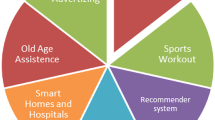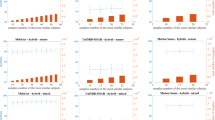Abstract
The increasing usage of mobile devices amounts to around 6.8 billion by 2022. This implies a substantial increase in the quantity of personal data that are managed. The paper surveys the most relevant contributions that pertain to human activity, behavioural patterns detection, demographics, health and body parameters. Moreover, significant aspects regarding data privacy are also analyzed. The paper also defines relevant research questions and challenges.
Access this chapter
Tax calculation will be finalised at checkout
Purchases are for personal use only
Similar content being viewed by others
References
Rajkumar, N., Kannan, E.: Attribute-based collusion resistance in group-based cloud data sharing using LKH model. J. Circ. Syst. Comput. 29(02), 2030001 (2020)
Tolosana, R., et al.: Child-computer interaction: recent works, new dataset, and age detection. arXiv (2021)
Abuhamad, M., Abusnaina, A., Nyang, D., Mohaisen, D.: Sensor-based continuous authentication of smartphones’ users using behavioral biometrics: a contemporary survey. arXiv. (2020)
Hussain, A., et al.: Security framework for IOT based real-time health applications. Electronics 10(6), 719 (2021)
Ellavarason, E., Guest, R., Deravi, F., Sanchez-Riello, R., Corsetti, B.: Touch-dynamics based behavioural biometrics on mobile devices-a review from a usability and performance perspective. ACM Comput. Surv. (CSUR) 53(6), 1–36 (2020)
General Data Protection Regulation (2022). https://gdprinfo.eu/ro
Aljeraisy, A., Barati, M., Rana, O., Perera, C.: Privacy laws and privacy by design schemes for the Internet of Things: a developer’s perspective. ACM Comput. Surv. 54(5), 1–38 (2021). Article 102
Barth, S., de Jong, M.D.T., Junger, M., Hartel, P.H., Roppelt, J.C.: Putting the privacy paradox to the test: online privacy and security behaviors among users with technical knowledge, privacy awareness, and financial resources. Telematics Inform. 41, 55–69 (2019)
European Commission: PriMa: Privacy Matters, H2020-MSCA-ITN-2019-860315 (2022). https://www.prima-itn.eu/
European Commission: TReSPAsS-ETN: TRaining in Secure and PrivAcy-preserving biometricS, H2020-MSCAITN-2019-860813 (2022). https://www.trespass-etn.eu/
Labati, R.D., Piuri, V., Scotti, F.: Biometric privacy protection: guidelines and technologies. In: Obaidat, M.S., Sevillano, J.L., Filipe, J. (eds.) ICETE 2011. CCIS, vol. 314, pp. 3–19. Springer, Heidelberg (2012). https://doi.org/10.1007/978-3-642-35755-8_1
Davarci, E., Soysal, B., Erguler, I., Aydin, S.O., Dincer, O., Anarim, E.: Age group detection using smartphone motion sensors. In: Proceedings of the European Signal Processing Conference (2017)
Nguyen, T., Roy, A., Memon, N.: Kid on the phone! Toward automatic detection of children on mobile devices. Comput. Secur. 84, 334–348 (2019)
Jain, A., Kanhangad, V.: Investigating gender recognition in smartphones using accelerometer and gyroscope sensor readings. In: Proceedings of the International Conference on Computational Techniques in Information and Communication Technologies (2016)
Meena, T., Sarawadekar, K.: Gender recognition using in-built inertial sensors of smartphone. In: Proceedings of the IEEE Region 10 Conference, pp. 462–467 (2020)
Singh, S., Shila, D.M., Kaiser, G.: Side channel attack on smartphone sensors to infer gender of the user: poster abstract. In: Proceedings of the Conference on Embedded Networked Sensor Systems, pp. 436–437 (2019)
Ngo, T.T., et al.: OU-ISIR wearable sensor-based gait challenge: age and gender. In: Proceedings of the International Conference on Biometrics (2019)
Sabir, A., Maghdid, H., Asaad, S., Ahmed, M., Asaad, A.: Gait-based gender classification using smartphone accelerometer sensor. In: Proceedings of the International Conference on Frontiers of Signal Processing, pp. 12–20 (2019)
Acien, A., Morales, A., Fierrez, J., Vera-Rodriguez, R., Hernandez-Ortega, J.: Active detection of age groups based on touch interaction. IET Biom. 8(1), 101–108 (2019)
Miguel-Hurtado, O., Stevenage, S., Bevan, C., Guest, R.: Predicting sex as a soft-biometrics from device interaction swipe gestures. Pattern Recogn. Lett. 79, 44–51 (2016)
Jain, A., Kanhangad, V.: Gender recognition in smartphones using touchscreen gestures. Pattern Recogn. Lett. 125, 604–611 (2019)
Almaatouq, A., Prieto-Castrillo, F., Pentland, A.: Mobile communication signatures of unemployment. In: Spiro, E., Ahn, Y.-Y. (eds.) SocInfo 2016. LNCS, vol. 10046, pp. 407–418. Springer, Cham (2016). https://doi.org/10.1007/978-3-319-47880-7_25
Yuan, Y., Raubal, M., Liu, Y.: Correlating mobile phone usage and travel behavior-a case study of Harbin, China. Comput. Environ. Urban Syst. 36(2), 118–130 (2012)
Scherrer, L., Tomko, M., Ranacher, P., Weibel, R.: Travelers or locals? Identifying meaningful sub-populations from human movement data in the absence of ground truth. EPJ Data Sci. 7(1), 1–21 (2018). https://doi.org/10.1140/epjds/s13688-018-0147-7
Riederer, C., Zimmeck, S., Phanord, C., Chaintreau, A., Bellovin, S.: I don’t have a photograph, but you can have my footprints. Revealing the demographics of location data. In: Proceedings of the ACM on Conference on Online Social Networks, pp. 185–195 (2015)
Wu, L., et al.: Inferring demographics from human trajectories and geographical context. Comput. Environ. Urban Syst. 77(2019), 101368 (2019)
The eXtreme Gradient Boosting library (2022). https://xgboost.ai/about
Neal, T., Woodard, D.: A gender-specific behavioral analysis of mobile device usage data. In: Proceedings of the International Conference on Identity, Security, and Behavior Analysis, pp. 1–8 (2018)
Chen, K., Zhang, D., Yao, L., Guo, B., Yu, Z., Liu, Y.: Deep learning for sensor-based human activity recognition: overview, challenges, and opportunities. ACM Comput. Surv. 54(4), 1–40 (2021). https://doi.org/10.1145/3447744. Article 77
Sun, L., Zhang, D., Li, B., Guo, B., Li, S.: Activity recognition on an accelerometer embedded mobile phone with varying positions and orientations. In: Yu, Z., Liscano, R., Chen, G., Zhang, D., Zhou, X. (eds.) UIC 2010. LNCS, vol. 6406, pp. 548–562. Springer, Heidelberg (2010). https://doi.org/10.1007/978-3-642-16355-5_42
Anjum, A., Ilyas, M.: Activity recognition using smartphone sensors. In: Proceedings of the IEEE Consumer Communications and Networking Conference, pp. 914–919 (2013)
Thomaz, E., Essa, I., Abowd, G.D.: A practical approach for recognizing eating moments with wrist-mounted inertial sensing. In: Proceedings of the ACM International Joint Conference on Pervasive and Ubiquitous Computing, pp. 1029–1040 (2015)
Santani, D., Do, T., Labhart, F., Landolt, S., Kuntsche, E., Gatica-Perez, D.: DrinkSense: characterizing youth drinking behavior using smartphones. IEEE Trans. Mob. Comput. 17(10), 2279–2292 (2018)
Arnold, Z., Larose, D., Agu, E.: Smartphone inference of alcohol consumption levels from gait. In: 2015 International Conference on Healthcare Informatics, pp. 417–426 (2015)
Chang, L., et al.: SleepGuard: capturing rich sleep information using smartwatch sensing data. Proc. ACM Interact. Mob. Wearable Ubiquit. Technol. 2(3), 1–34 (2018)
Wan, N., Lin, G.: Classifying human activity patterns from smartphone collected GPS data: a fuzzy classification and aggregation approach. Trans. GIS 20(6), 869–886 (2016)
Chen, Z., Zhang, L., Jiang, C., Cao, Z., Cui, W.: WiFi CSI based passive human activity recognition using attention based BLSTM. IEEE Trans. Mob. Comput. 18(11), 2714–2724 (2018)
Ma, Y., et al.: Location-and person-independent activity recognition with WiFi, deep neural networks, and reinforcement learning. ACM Trans. Internet Things 2(1), 1–25 (2021)
Yao, Y., Song, L., Ye, J.: Motion-To-BMI: using motion sensors to predict the body mass index of smartphone users. Sensors 20(4), 1134 (2020)
Albanese, E., et al.: Body mass index in midlife and dementia: systematic review and meta-regression analysis of 589,649 men and women followed in longitudinal studies. Alzheimer’s Dement. Diagn. Assess. Dis. Monit. 8, 165–178 (2017)
Dobner, J., Kaser, S.: Body mass index and the risk of infection-from underweight to obesity. Clin. Microbiol. Infect. 24(1), 24–28 (2018)
Garcia-Ceja, E., Riegler, M., Nordgreen, T., Jakobsen, P., Oedegaard, K.J., Torresen, J.: Mental health monitoring with multimodal sensing and machine learning: a survey. Pervasive Mob. Comput. 51, 1–26 (2018)
Arroyo-Gallego, T., et al.: Detection of motor impairment in Parkinson’s disease via mobile touchscreen typing. IEEE Trans. Biomed. Eng. 64(9), 1994–2002 (2017)
Castrillon, R., et al.: Characterization of the handwriting skills as a biomarker for Parkinson disease. In: IEEE International Conference on Automatic Face and Gesture Recognition (FG 2019) - Human Health Monitoring Based on Computer Vision (2019)
Bevan, C., Fraser, D.: Different strokes for different folks? Revealing the physical characteristics of smartphone users from their swipe gestures. Int. J. Hum Comput Stud. 88, 51–61 (2016)
Palmius, N., et al.: Detecting bipolar depression from geographic location data. IEEE Trans. Biomed. Eng. 64(8), 1761–1771 (2016)
Tal, A., Shinar, Z., Shaki, D., Codish, S., Goldbart, A.: Validation of contact-free sleep monitoring device with comparison to polysomnography. J. Clin. Sleep Med. 13(3), 517–522 (2017)
Behar, J., et al.: SleepAp: an automated obstructive sleep apnoea screening application for smartphones. IEEE J. Biomed. Health Inform. 19(1), 325–331 (2014)
Kostopoulos, P., Nunes, T., Salvi, K., Togneri, M., Deriaz, M.: StayActive: an application for detecting stress. In: Proceedings of the International Conference on Communications, Computation, Networks and Technologies (2015)
Neal, T., Canavan, S.: Mood versus identity: Studying the influence of affective states on mobile biometrics. In: Proceedings of the IEEE International Conference on Automatic Face and Gesture (2020)
Quiroz, J.C., Geangu, E., Yong, M.H.: Emotion recognition using smart watch sensor data: mixed-design study. JMIR Ment. Health 5(3), e10153 (2018)
Cao, B., et al.: DeepMood: modeling mobile phone typing dynamics for mood detection. In: Proceedings of the ACM SIGKDD International Conference on Knowledge Discovery and Data Mining (2017)
Hung, G., Yang, P., Chang, C., Chiang, J., Chen, Y.: Predicting negative emotions based on mobile phone usage patterns: an exploratory study. JMIR Res. Protoc. 5(3), e160 (2016)
Gao, Y., Bianchi-Berthouze, N., Meng, H.: What does touch tell us about emotions in touchscreen-based gameplay? ACM Trans. Comput.-Hum. Interact. 19(4), 1–30 (2012)
Shah, S., Teja, J., Bhattacharya, S.: Towards affective touch interaction: predicting mobile user emotion from finger strokes. J. Interact. Sci. 3(1), 1–15 (2015). https://doi.org/10.1186/s40166-015-0013-z
Zhang, X., Li, W., Chen, X., Lu, S.: MoodExplorer: towards compound emotion detection via smartphone sensing. Proc. ACM Interact. Mob. Wearable Ubiquit. Technol. 1(4), 1–30 (2018)
Nguyen, K.A., Akram, R.N., Markantonakis, K., Luo, Z., Watkins, C.: Location tracking using smartphone accelerometer and magnetometer traces. In: Proceedings of the International Conference on Availability, Reliability and Security (2019)
Hua, J., Shen, Z., Zhong, S.: We can track you if you take the metro: tracking metro riders using accelerometers on smartphones. IEEE Trans. Inf. Forensics Secur. 12(2), 286–297 (2017)
Han, J., Owusu, E., Nguyen, L.T., Perrig, A., Zhang, J.: ACComplice: location inference using accelerometers on smartphones. In: Proceedings of the 4th International Conference on Communication Systems and Networks (2012)
Singh, V., Aggarwal, G., Ujwal, B.V.S.: Ensemble based real-time indoor localization using stray WiFi signal. In: Proceedings of the IEEE International Conference on Consumer Electronics (ICCE 2018), pp. 1–5 (2018)
Cai, L., Chen, H.: TouchLogger: inferring keystrokes on touch screen from smartphone motion. HotSec 11, 9 (2011)
Owusu, E., Han, J., Das, S., Perrig, A., Zhang, J.: ACCessory: password inference using accelerometers on smartphones. In: Proceedings of the Workshop on Mobile Computing Systems and Applications (2012)
Aviv, A.J., Sapp, B., Blaze, M., Smith, J.M.: Practicality of accelerometer side channels on smartphones. In: Proceedings of the Annual Computer Security Applications Conference (2012)
Author information
Authors and Affiliations
Corresponding author
Editor information
Editors and Affiliations
Rights and permissions
Copyright information
© 2023 The Author(s), under exclusive license to Springer Nature Switzerland AG
About this paper
Cite this paper
Bocu, R., Bocu, D. (2023). Next Generation Mobile Sensors: Review Regarding the Significance of Deep Learning and Privacy Techniques for Data-Driven Soft Sensors. In: Barolli, L. (eds) Advanced Information Networking and Applications. AINA 2023. Lecture Notes in Networks and Systems, vol 655. Springer, Cham. https://doi.org/10.1007/978-3-031-28694-0_1
Download citation
DOI: https://doi.org/10.1007/978-3-031-28694-0_1
Published:
Publisher Name: Springer, Cham
Print ISBN: 978-3-031-28693-3
Online ISBN: 978-3-031-28694-0
eBook Packages: Intelligent Technologies and RoboticsIntelligent Technologies and Robotics (R0)




